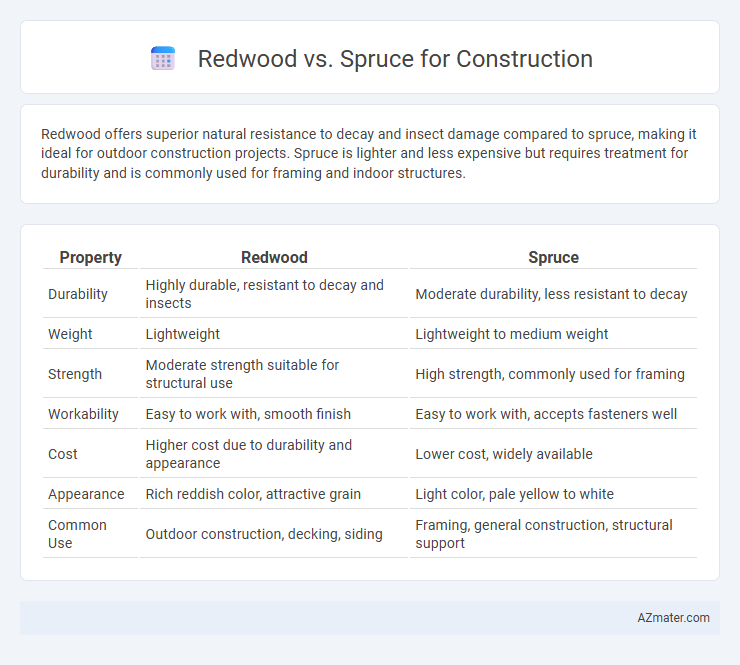Redwood offers superior natural resistance to decay and insect damage compared to spruce, making it ideal for outdoor construction projects. Spruce is lighter and less expensive but requires treatment for durability and is commonly used for framing and indoor structures.
Table of Comparison
| Property | Redwood | Spruce |
|---|---|---|
| Durability | Highly durable, resistant to decay and insects | Moderate durability, less resistant to decay |
| Weight | Lightweight | Lightweight to medium weight |
| Strength | Moderate strength suitable for structural use | High strength, commonly used for framing |
| Workability | Easy to work with, smooth finish | Easy to work with, accepts fasteners well |
| Cost | Higher cost due to durability and appearance | Lower cost, widely available |
| Appearance | Rich reddish color, attractive grain | Light color, pale yellow to white |
| Common Use | Outdoor construction, decking, siding | Framing, general construction, structural support |
Introduction: Redwood vs Spruce in Construction
Redwood offers superior natural resistance to decay and insects, making it ideal for outdoor construction projects, while spruce provides a strong, lightweight alternative commonly used for interior framing and structural support. The density and durability of redwood contribute to longevity in exposed environments, whereas spruce's uniform grain and ease of handling support efficient building processes. Choosing between redwood and spruce depends on the project's environmental exposure, budget considerations, and desired structural properties.
Physical Properties Comparison
Redwood offers superior resistance to decay and insect damage due to its natural oils, making it highly durable for outdoor construction projects compared to spruce. Spruce has a higher strength-to-weight ratio, providing excellent structural support while being lighter, which is ideal for framing and indoor uses. Redwood's lower density results in better insulation properties, whereas spruce has greater stiffness, contributing to enhanced load-bearing capacity.
Durability and Longevity
Redwood offers superior natural resistance to decay, insects, and moisture compared to spruce, making it a preferred choice for outdoor construction and exposed structures. Spruce, while more affordable and readily available, requires treatment to enhance its durability and protect against environmental damage. The exceptional longevity of redwood, often exceeding several decades without significant degradation, makes it ideal for projects demanding long-term structural integrity.
Resistance to Weather and Moisture
Redwood exhibits superior resistance to weather and moisture due to its natural oils and dense grain, making it highly durable in outdoor construction projects. Spruce, while commonly used for framing and structural purposes, is more susceptible to moisture absorption and requires additional treatment to withstand prolonged exposure to harsh weather conditions. The inherent rot resistance of redwood significantly extends the lifespan of decking, siding, and outdoor furniture compared to untreated spruce.
Workability and Ease of Use
Redwood offers excellent workability due to its straight grain and soft texture, making it easy to saw, nail, and shape without splintering. Spruce is lightweight and relatively easy to work with, but its finer grain requires more care to avoid dents and damage during construction. Both woods are favored for their ease of handling, but redwood's natural oils enhance tool life and reduce wear during cutting and finishing processes.
Sustainability and Environmental Impact
Redwood offers superior sustainability in construction due to its natural resistance to decay, requiring fewer chemical treatments compared to spruce, which often needs preservatives that can harm the environment. Spruce grows faster and is more abundant, making it a more renewable resource, but its shorter lifespan in construction demands more frequent replacement, increasing environmental costs. Choosing redwood reduces long-term environmental impact by minimizing maintenance and replacement, while spruce supports sustainable forestry practices when sourced responsibly.
Cost and Availability
Redwood typically commands a higher price due to its limited availability and premium durability, making it a costlier choice for construction projects. Spruce is more abundant and widely accessible, resulting in lower costs and easier procurement for large-scale building. Builders often select spruce for budget-conscious projects while opting for redwood when long-term durability and aesthetic appeal justify the investment.
Common Construction Applications
Redwood and spruce are both popular choices in construction, with spruce commonly used for structural framing due to its strength-to-weight ratio and affordability. Redwood is favored for exterior applications such as decking, siding, and outdoor furniture because of its natural resistance to decay and insects. Spruce is widely utilized in interior construction and plywood manufacturing, making it a versatile option for walls, ceilings, and flooring underlayment.
Maintenance Requirements
Redwood requires less maintenance than spruce due to its natural resistance to decay, insects, and moisture, reducing the need for frequent sealing or treatment. Spruce, being softer and less dense, often demands regular protective coatings to prevent rot and insect damage in construction applications. Choosing redwood can lead to lower long-term upkeep costs and increased durability in outdoor or high-exposure building projects.
Conclusion: Best Choice for Your Project
Redwood offers superior durability, natural resistance to decay, and an appealing rich color, making it ideal for outdoor construction projects requiring long-lasting aesthetics. Spruce is more cost-effective, easier to work with, and commonly used for structural framing where budget and availability are key factors. Selecting redwood is best for premium, weather-exposed applications, while spruce suits interior framing or projects with tight budgets.

Infographic: Redwood vs Spruce for Construction
 azmater.com
azmater.com